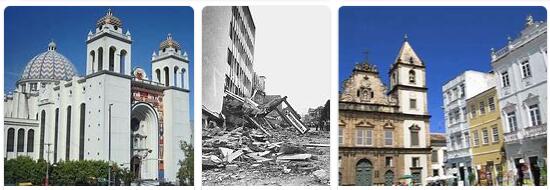El Salvador Recent History
Military authoritarianism
In 1931, General Maximiliano Hernández Martínez, came to power after a coup against the civilian president Arturo Araujo. Martínez established an ultra-conservative and authoritarian government and with the army repressed an uprising of peasants and indigenous people in the west of the country, which resulted in the death of thousands of people (some authors put it at thirty thousand) and the murder of the communist leader Farabundo Marti.
General Martínez was deposed by a general strike in 1944, called Huelga de Brazos Caídos (El Salvador). But his government marked the beginning of a series of successive authoritarian military governments, which would end in 1979 with a coup against General Carlos Humberto Romero, of the National Conciliation Party (PCN) and the establishment of the self-appointed Revolutionary Government Junta. General Romero tried to toughen the dictatorship even more instead of making it more flexible. His presidential term, inaugurated after a scandalous electoral fraud, was wearing thin very quickly. The death squads bloodied the country without silencing the popular protests. The guerrilla was getting stronger.
Faced with the rise of popular struggles, the United States increased its intervention, becoming even more involved in the internal situation, managing to keep up to a million dollars a day as “aid” to the governments of that time.
Civil war
The year 1980 had been very decisive for the beginning of the civil war in El Salvador, due to the series of repressive events by the State and paramilitary organizations, refuted by actions and responses of the guerrilla organizations.
The 24 of March of 1980, Archbishop Oscar Arnulfo Romero, Archbishop of San Salvador, was assassinated by a sniper while celebrating Mass in the Chapel of the Hospital Divina Providencia, located to the west of the capital city, after having demanded the United States withdraw its military support to the Salvadoran regime and order, in the name of God, the Junta itself to end the repression. Major Roberto D’Aubuisson was charged as an organizer of the crime and was never brought to trial. The perpetrator of the attack was Army Captain Álvaro Rafael Saravia, currently with residence and protection in the United States.
The funerals, held in the Metropolitan Cathedral of San Salvador on March 30, 1980, became a pitched battle in which the security forces attacked thousands of Salvadorans concentrated in the cathedral square, including members of the Popular Revolutionary Bloc. The result: more than 40 dead and 200 wounded.
Monsignor’s assassination was followed by other terrible acts of violence against a Church committed to the Salvadoran people.
On December 2, 1980, the nuns Ita Ford, Maura Clarke and Dorothy Kazel and the lay missionary Jean Donovan were raped and murdered by five members of the National Guard. The nuns and the laity belonged to the congregations of the Maryknoll Sisters and the Ursuline Sisters of New York. They had been raped before being shot dead. These nuns had defended the Salvadorans from the terror unleashed by their government.
In El Salvador, for the crime of the four North American nuns, the five agents of the National Guard were sentenced to 30 years in prison in 1984. Of these, three were released four years later. The rape and murder of the nuns by military hitmen led the US government to suspend military aid to the Salvadoran government… for a month.
The 16 of November of 1989, members of the Atlacatl Battalion of the Salvadoran army murdered in San Salvador to Spanish-Salvadoran priests Ignacio Ellacuría, rector of the Central American University (UCA), and the rector, Ignacio Martin Baro, other three religious Spaniards and one Salvadoran and a domestic worker and her daughter.
It has recently been made public that the CIA and the Spanish secret services knew that the Salvadoran military were going to kill the six Jesuits from the Central American University.
Nine soldiers were tried for the crime, among them the director of the San Salvador Military School, Colonel Guillermo Alfredo Benavides, sentenced to 30 years in prison and released in 1993 after promulgating the amnesty law that pardoned all the atrocities committed during the civil war in El Salvador.
The war ended in 1992 when the combatants of the Farabundo Martí National Liberation Front (FMLN), made up of five leftist groups, and the right-wing government of then-President Alfredo Cristiani, signed the Peace Accords on January 16, 1992 in Chapultepec., Mexico, which ensured political and military reforms, but did not deepen the social or economic aspects, definitively postponing any improvement or progress on both issues.
Postwar period
According to educationvv, Neoliberal policies continued to deepen the social deterioration of the country with governments very close to the United States. On the other hand, the last presidential elections, held on 15 of March of 2009, gave the winner a journalist Mauricio Funes of the FMLN party reestablished relations with Cuba and promotes social welfare policies.
The FMLN from power promotes a government program that is based on the redistribution of national wealth. Since coming to power, the left has proposed a new fiscal pact that will shift the burden of taxes to the richest and free the poor and the middle class of their burden. In El Salvador until February 2011, the highest income sectors received from the state almost twice as many subsidies as the poorest. This plan pitted the government against business sectors, refusing to pay more taxes and redistribute income.






